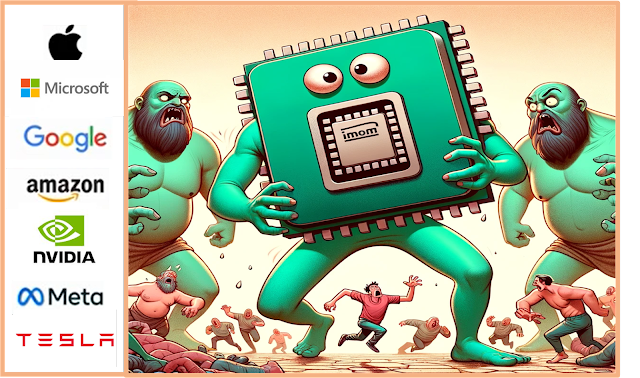Remembering the famous adage, “When the wise man points to the moon, the fool looks to the finger,” GreenSI wonders this week if generative AI is the finger or the moon?
Indeed, generative AIs have appeared recently and are transforming the IT landscape, as we have covered in several posts. But are we not observing something more structuring than the new uses of AI, with a change in the IT era where computing power would become preponderant?
All ten of us moved from one dominant IT platform to another. First the mainframethen thedepartmental ITTHE client server (Or Intel played a key role with Moore’s law) and finally the Cloud since 2010 with internet. Each time, the contributions of each platform consolidate the achievements of the previous platform, and structure the development of new software, new uses and ultimately the entire industry. However, generative AI could only emerge because the Internet platform existed (to produce massive data) and because advances in chips have multiplied the available power.
It is therefore legitimate to wonder if we have not just entered into the era of a new IT platform, characterized by the computing power that makes it possible to achieve uses never before achieved.
This platform would also form a bridge with another promised platform, but more distant (2030?), which is already defined by a break in computing power: the quantum computer.
Would it be the return of “brute force”, as it is sometimes called, which would be the key to new uses for those who hold it, and which will remain inaccessible to those stuck on the previous platform?
To illustrate this hypothesis, this post explores how the entry of Nvidia in the very exclusive club of “Big Tech” (Apple, Amazon, Meta, Microsoft and Google). It also recalls the links between Nvidia And You’re here, which, behind its electric cars, also hides computing power never equaled in its sector, whether in each car or in its centralized IT for learning autonomous driving.
Nvidia’s meteoric rise, driven primarily by its innovation in artificial intelligence (AI) chips, has redefined the boundaries and scope of this club. Its members were focused on uses and material directly linked to billions of users, but with Nvidia Or You’re herethis link with users is secondary. It is indeed the power of the technological platform that has raised them to these valuationsrespectively two and one billion dollars, and contributed to the three billion Microsoft. These are the first global valuations.
Likewise, contrasting with the consolidations by acquisitions which were the custom, for example, of Meta (Instagram, Whatsapp, Quest, …), Apple or Google; Nvidia or Tesla no longer worked massive investments in R&D and partnerships.
Nvidia, founded in 1993, initially made a name for itself with its video processing graphics (GPU) in the video game industry. However, over the years, the company successfully pivoted to more powerful chips that led it to artificial intelligence. With the explosion of needs triggered by ChatGPT, it has made its GPUs a cornerstone in the development of AI technologies around the world, from machine learning to deep learning.
Moreover, historically, Tesla has used Nvidia chips to power its autonomous driving system, Autopilot. Nvidia processors, like those in the Tegra line, were at the heart of early versions of Tesla’s Autopilot hardware, providing the computing power needed to process sensor data and run autonomous driving algorithms. Then Tesla transitioned to internal development of its own self-driving chips, known as Hardware 3 or FSD (Full Self-Driving). This R&D investment by Tesla was able to reduce its dependence on Nvidia for its high-performance computing needs for autonomous driving.
Today Nvidia is essential in AI. First with the HGX H100 cards for generative AI. But Nvidia last month introduced the HGX H200 based on the Hopper architecture, designed to handle large amounts of data for generative AI and other demanding applications. This enthusiasm and its uniqueness in the market has created a current shortage for the generative AI market. Even for “Big Tech” and we can compare this to the announcement by Sam Altman, CEO of OpenAI, to launch into building his own chip. This need for power is at the heart of new economic models.
Several other founders have embarked on this race, such as AMD or Intel, and will power these next platforms, but not for a few years. This advance by Nvidia is therefore very real and can also be measured in the impact of the strategies of the former members of “Big Tech”, who need Nvidia, but who also know that it is one of their next challengers.
For GreenSI, this transition is therefore not only a change of course for Nvidia, but foreshadows a profound change in the way technology will be developed, applied and perceived in the decades to come. We are witnessing a reassessment of what constitutes power in the technology sector, in this case, specialized computing power.
Nvidia’s AI chips aren’t just hardware components, they are the foundations on which a future IT platform rests, for AI, but by extension, for many industries. We are of course thinking of health, where Nvidia’s investments are significant, but also of all the other industries where digital twins, autonomous robots and artificial intelligence will transform uses.
So, the question “what is the total computing power of our company and are we willing to multiply it to change our model?” is certainly a good question for a Management Committee.
AI and data, as important as they are, should not obscure our reflection on the technological prowess of Nvidia and the transformation of the automotive industry by Telsa with computing power. Finally, the moon is perhaps this computing power.
